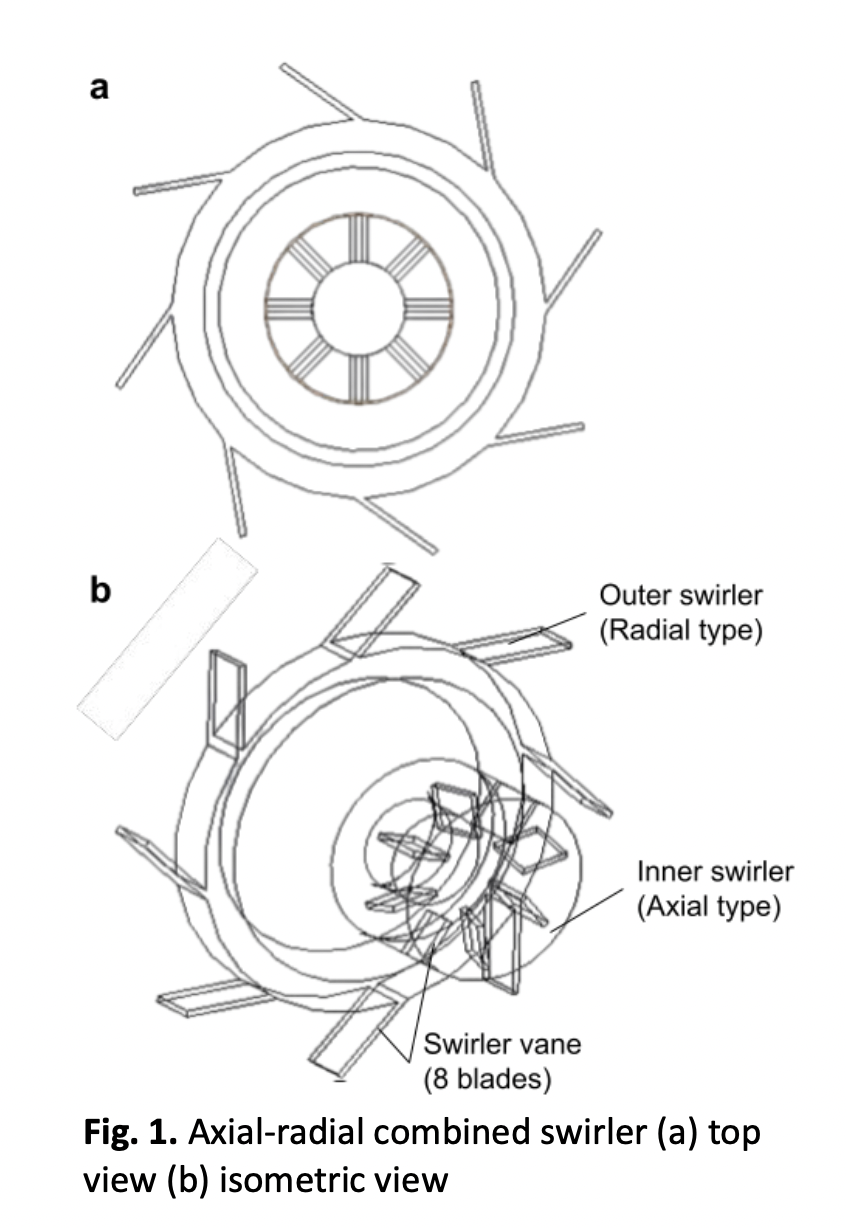CFD Simulation Analysis of Non-Premixed Combustion using a Novel Axial-Radial Combined Swirler for Emission Reduction Enhancement
DOI:
https://doi.org/10.37934/cfdl.15.6.111Keywords:
Axial swirler, Emissions, Non-Premixed Combustion, Radial swirler, Temperature, velocityAbstract
Combustion industries for many decades dealing with the issues in reducing the emissions without affecting the performance of combustion. The present study aims to investigate the performance of swirler mechanism which combining between both axial and radial types to reduce emissions and increase the mixing process via the non-premixed method. Each of axial and radial swirler consisted with 8 blades vane. Swirl angle for radial swirler is 35° and inclination angle for axial swirler is 15°. The swirler is designed using Solidworks software package and CFD analysis was then performed using ANSYS Fluent software package. The fuel used is liquefied petroleum gas (LPG) gas which contained 30% propane and 70% butane. The turbulence model standard k-epsilon was used in this study. The result found that the combined swirler was capable to reduce CO emission as the complete reaction into CO2 component was higher. This is due to the broader region of temperature and higher velocity magnitude produced by the combined swirler. However, the maximum temperature result for axial swirler was higher than the combined swirler. As a recommendation, the inclination blade angle in the axial swirler of the combined swirler should be increased to increase the temperature value
Downloads
References
Subash, Arman Ahamed, Senbin Yu, Xin Liu, Michael Bertsch, Robert-Zoltan Szasz, Zhongshan Li, Xue-Song Bai, Marcus Aldén, and Daniel Lörstad. "Flame investigations of a laboratory-scale CECOST swirl burner at atmospheric pressure conditions." Fuel 279 (2020): 118421. https://doi.org/10.1016/j.fuel.2020.118421
Hasan, Karrar S., Wisam A. Abd Al-wahid, and H. H. S. Khwayyir. "Flashback and combustion stability in swirl burners." In IOP Conference Series: Materials Science and Engineering, vol. 928, no. 2, p. 022045. IOP Publishing, 2020. https://doi.org/10.1088/1757-899X/928/2/022045
Mansouri, Zakaria, and Toufik Boushaki. "Investigation of large-scale structures of annular swirling jet in a non-premixed burner using delayed detached eddy simulation." International Journal of Heat and Fluid Flow 77 (2019): 217-231. https://doi.org/10.1016/j.ijheatfluidflow.2019.04.007
Hu, Zhenwei, Jie Sun, Jin Wang, Ting Ma, Jakov Baleta, and Bengt Sundén. "Effects of swirler blade angle and actuator applied voltage on combustion characteristics and cooling effectiveness." Fuel 323 (2022): 124434. https://doi.org/10.1016/j.fuel.2022.124434
Hakim, Kbab, Hamitouche Toufik, and Y. Mouloudj. "Study and simulation of the thrust vectoring in supersonic nozzles." Journal of Advanced Research in Fluid Mechanics and Thermal Sciences 93, no. 1 (2022): 13-24. https://doi.org/10.37934/arfmts.93.1.1324
Hosseini, Amirjavad Ahmadian, Maryam Ghodrat, Mohammad Moghiman, and Seyed Hadi Pourhoseini. "Numerical study of inlet air swirl intensity effect of a Methane-Air Diffusion Flame on its combustion characteristics." Case Studies in Thermal Engineering 18 (2020): 100610. https://doi.org/10.1016/j.csite.2020.100610
Matthujak, Anirut, Mana Wichangarm, Thanarath Sriveerakul, Sedthawatt Sucharitpwatskul, and Sutthisak Phongthanapanich. "Numerical investigation on the influences of swirling flow to thermal efficiency enhancement of an LPG-energy saving burner." Case Studies in Thermal Engineering 28 (2021): 101466. https://doi.org/10.1016/j.csite.2021.101466
Pashchenko, Dmitry. "Hydrogen-rich fuel combustion in a swirling flame: CFD-modeling with experimental verification." International Journal of Hydrogen Energy 45, no. 38 (2020): 19996-20003. https://doi.org/10.1016/j.ijhydene.2020.05.113
Ferziger, Joel H., Milovan Perić, and Robert L. Street. Computational methods for fluid dynamics. Vol. 3. Berlin: springer, 2002.
Ansys, I. "ANSYS meshing user’s guide." vol 15317 (2013): 724-746.
oo, Seongpil, Sanghyeok Kwak, Youngbin Yoon, Sumin Hong, and Daesik Kim. "Experimental and numerical analysis of effect of fuel line length on combustion instability for H2/CH4 gas turbine combustor." International Journal of Hydrogen Energy 46, no. 76 (2021): 38119-38131. https://doi.org/10.1016/j.ijhydene.2021.09.031
M., E.A., F.T.M.G.H. M., and I.I. ."Effect of Combustor Diameter on Natural Gas Combustion Characteristic" in Global Journal of ENgineering Science and Research Management 2, no.12 (2015): 9-21.
Mafra, Marcos R., Fábio Luis Fassani, Everton F. Zanoelo, and Waldir A. Bizzo. "Influence of swirl number and fuel equivalence ratio on NO emission in an experimental LPG-fired chamber." Applied Thermal Engineering 30, no. 8-9 (2010): 928-934. https://doi.org/10.1016/j.applthermaleng.2010.01.004
Ibrahim, I. A., A. M. Elzallat, M. M. Elsakka, T. M. Farag, and H. M. Gad. "Numerical study of kerosene spray and combustion characteristics using an air-blast atomizer." Energy Reports 8 (2022): 5974-5986. https://doi.org/10.1016/j.egyr.2022.04.046
Enagi, Ibrahim I., K. A. Al-Attab, and Z. A. Zainal. "Combustion chamber design and performance for micro gas turbine application." Fuel processing technology 166 (2017): 258-268. https://doi.org/10.1016/j.fuproc.2017.05.037
Dixit, Shivanshu, Arvind Kumar, Suraj Kumar, Nitin Waghmare, Harish C. Thakur, and Sabah Khan. "CFD analysis of biodiesel blends and combustion using Ansys Fluent." Materials Today: Proceedings 26 (2020): 665-670. https://doi.org/10.1016/j.matpr.2019.12.362
Erkuş, Barış, M. İhsan Karamangil, and Ali Sürmen. "Designing a prototype LPG injection electronic control unit for a carburetted gasoline engine." Uludağ Üniversitesi Mühendislik Fakültesi Dergisi 20, no. 2 (2015): 141-153. https://doi.org/10.17482/uujfe.33667
Li, Xinzhuo, Minsung Choi, Chanho Jung, Yeseul Park, and Gyungmin Choi. "Effects of the staging position and air− LPG mixing ratio on the combustion and emission characteristics of coal and gas co-firing." Energy 254 (2022): 124314. https://doi.org/10.1016/j.energy.2022.124314
Patel, Vipul, and Rupesh Shah. "Experimental investigation on flame appearance and emission characteristics of LPG inverse diffusion flame with swirl." Applied Thermal Engineering 137 (2018): 377-385. https://doi.org/10.1016/j.applthermaleng.2018.03.105
Gherman, Bogdan, Ion Mălăel, Florin Florean, and Ionuţ Porumbel. "Experimental combustion chamber simulation at transient regimes." In E3S Web of Conferences, vol. 85, p. 02006. EDP Sciences, 2019. https://doi.org/10.1051/e3sconf/20198502006



























